Analyzing Purchase Intentions: A Case Study of Indian Organic Apparel
VerifiedAdded on 2023/06/03
|7
|1907
|280
Case Study
AI Summary
This case study delves into the purchase intentions of Indian consumers regarding organic apparel, employing thematic analysis to understand the underlying factors influencing their decisions. The literature review examines the Planned Behavior Model, focusing on perspectives such as Perceived Behavioral Control, Subjective Norms, Attitude, Purchase Intention, and Socio-Economic and Demographic Factors. The study utilizes focus groups with diverse participants to gather qualitative data, which is then analyzed using both thematic and theoretical thematic approaches to enhance the robustness and validity of the findings. The research acknowledges limitations in generalizability due to the specific geographic location (Kerala, India) and sample demographics, while also highlighting measures taken to mitigate bias. The combined use of inductive and deductive analysis, along with the application of both thematic and theoretical thematic analysis, strengthens the interpretation of results and increases the potential for generalization to other research areas. Desklib provides students with access to similar case studies and solved assignments.

Running head: THEMATIC ANALYSIS
Thematic Analysis
Name of the Student
Name of the University
Author Note
Thematic Analysis
Name of the Student
Name of the University
Author Note
Paraphrase This Document
Need a fresh take? Get an instant paraphrase of this document with our AI Paraphraser
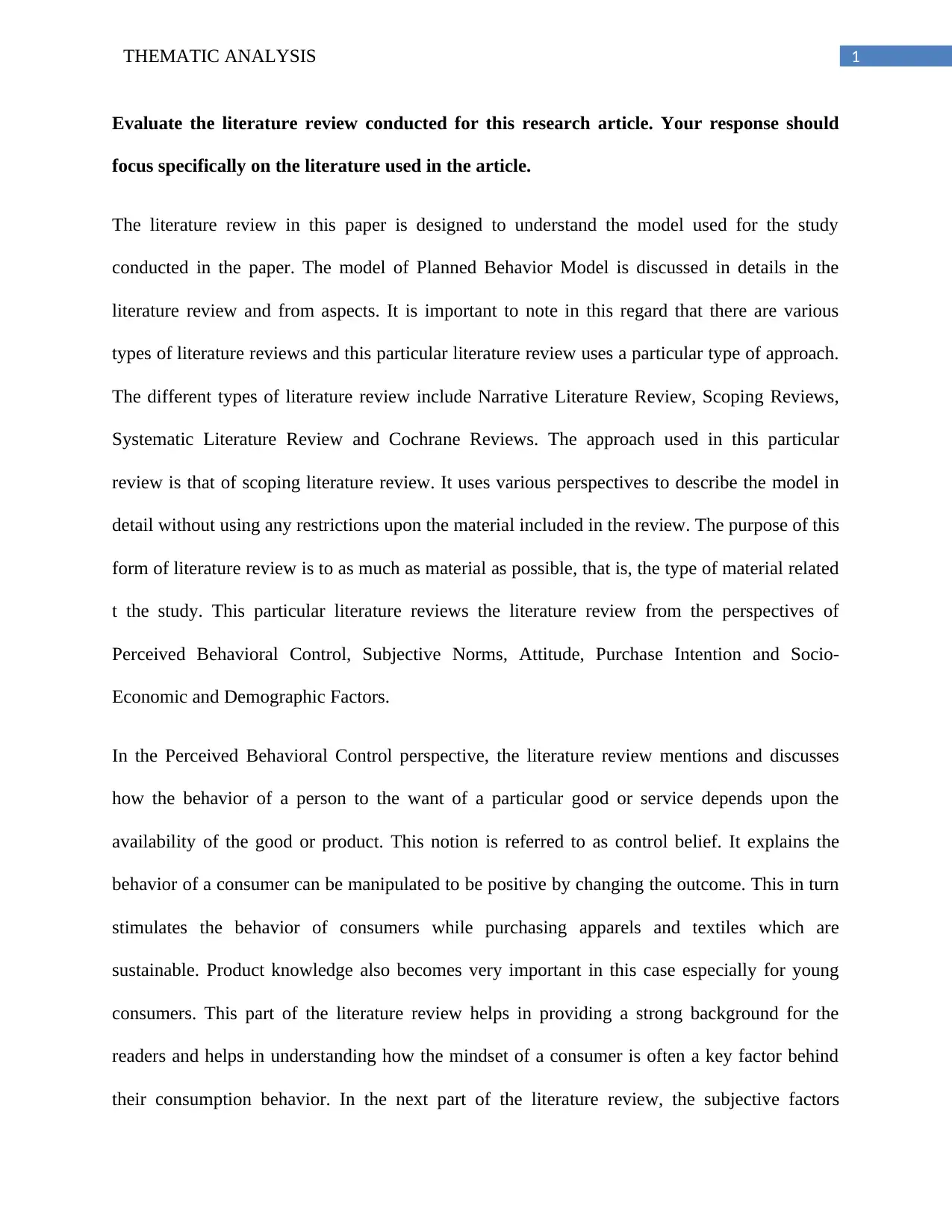
1THEMATIC ANALYSIS
Evaluate the literature review conducted for this research article. Your response should
focus specifically on the literature used in the article.
The literature review in this paper is designed to understand the model used for the study
conducted in the paper. The model of Planned Behavior Model is discussed in details in the
literature review and from aspects. It is important to note in this regard that there are various
types of literature reviews and this particular literature review uses a particular type of approach.
The different types of literature review include Narrative Literature Review, Scoping Reviews,
Systematic Literature Review and Cochrane Reviews. The approach used in this particular
review is that of scoping literature review. It uses various perspectives to describe the model in
detail without using any restrictions upon the material included in the review. The purpose of this
form of literature review is to as much as material as possible, that is, the type of material related
t the study. This particular literature reviews the literature review from the perspectives of
Perceived Behavioral Control, Subjective Norms, Attitude, Purchase Intention and Socio-
Economic and Demographic Factors.
In the Perceived Behavioral Control perspective, the literature review mentions and discusses
how the behavior of a person to the want of a particular good or service depends upon the
availability of the good or product. This notion is referred to as control belief. It explains the
behavior of a consumer can be manipulated to be positive by changing the outcome. This in turn
stimulates the behavior of consumers while purchasing apparels and textiles which are
sustainable. Product knowledge also becomes very important in this case especially for young
consumers. This part of the literature review helps in providing a strong background for the
readers and helps in understanding how the mindset of a consumer is often a key factor behind
their consumption behavior. In the next part of the literature review, the subjective factors
Evaluate the literature review conducted for this research article. Your response should
focus specifically on the literature used in the article.
The literature review in this paper is designed to understand the model used for the study
conducted in the paper. The model of Planned Behavior Model is discussed in details in the
literature review and from aspects. It is important to note in this regard that there are various
types of literature reviews and this particular literature review uses a particular type of approach.
The different types of literature review include Narrative Literature Review, Scoping Reviews,
Systematic Literature Review and Cochrane Reviews. The approach used in this particular
review is that of scoping literature review. It uses various perspectives to describe the model in
detail without using any restrictions upon the material included in the review. The purpose of this
form of literature review is to as much as material as possible, that is, the type of material related
t the study. This particular literature reviews the literature review from the perspectives of
Perceived Behavioral Control, Subjective Norms, Attitude, Purchase Intention and Socio-
Economic and Demographic Factors.
In the Perceived Behavioral Control perspective, the literature review mentions and discusses
how the behavior of a person to the want of a particular good or service depends upon the
availability of the good or product. This notion is referred to as control belief. It explains the
behavior of a consumer can be manipulated to be positive by changing the outcome. This in turn
stimulates the behavior of consumers while purchasing apparels and textiles which are
sustainable. Product knowledge also becomes very important in this case especially for young
consumers. This part of the literature review helps in providing a strong background for the
readers and helps in understanding how the mindset of a consumer is often a key factor behind
their consumption behavior. In the next part of the literature review, the subjective factors
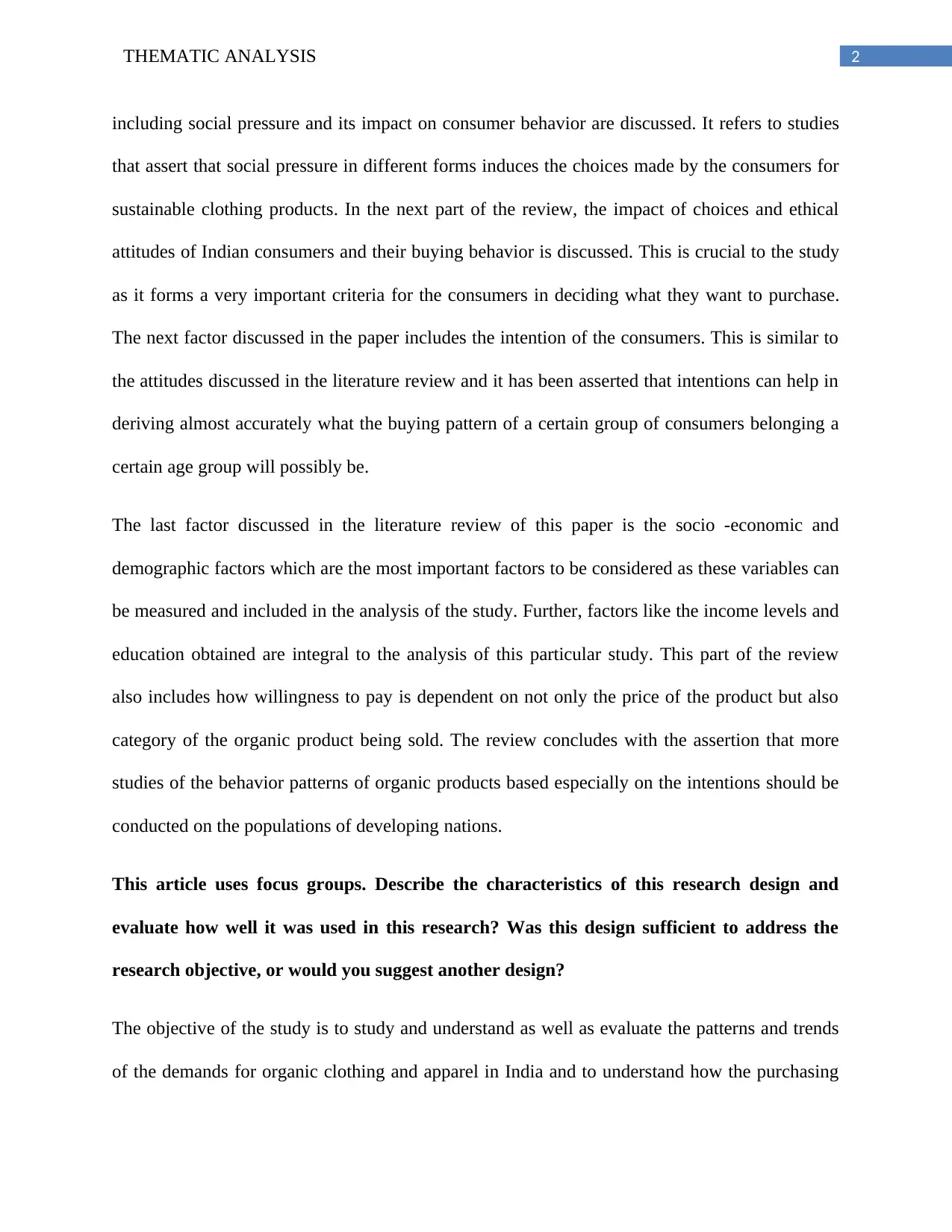
2THEMATIC ANALYSIS
including social pressure and its impact on consumer behavior are discussed. It refers to studies
that assert that social pressure in different forms induces the choices made by the consumers for
sustainable clothing products. In the next part of the review, the impact of choices and ethical
attitudes of Indian consumers and their buying behavior is discussed. This is crucial to the study
as it forms a very important criteria for the consumers in deciding what they want to purchase.
The next factor discussed in the paper includes the intention of the consumers. This is similar to
the attitudes discussed in the literature review and it has been asserted that intentions can help in
deriving almost accurately what the buying pattern of a certain group of consumers belonging a
certain age group will possibly be.
The last factor discussed in the literature review of this paper is the socio -economic and
demographic factors which are the most important factors to be considered as these variables can
be measured and included in the analysis of the study. Further, factors like the income levels and
education obtained are integral to the analysis of this particular study. This part of the review
also includes how willingness to pay is dependent on not only the price of the product but also
category of the organic product being sold. The review concludes with the assertion that more
studies of the behavior patterns of organic products based especially on the intentions should be
conducted on the populations of developing nations.
This article uses focus groups. Describe the characteristics of this research design and
evaluate how well it was used in this research? Was this design sufficient to address the
research objective, or would you suggest another design?
The objective of the study is to study and understand as well as evaluate the patterns and trends
of the demands for organic clothing and apparel in India and to understand how the purchasing
including social pressure and its impact on consumer behavior are discussed. It refers to studies
that assert that social pressure in different forms induces the choices made by the consumers for
sustainable clothing products. In the next part of the review, the impact of choices and ethical
attitudes of Indian consumers and their buying behavior is discussed. This is crucial to the study
as it forms a very important criteria for the consumers in deciding what they want to purchase.
The next factor discussed in the paper includes the intention of the consumers. This is similar to
the attitudes discussed in the literature review and it has been asserted that intentions can help in
deriving almost accurately what the buying pattern of a certain group of consumers belonging a
certain age group will possibly be.
The last factor discussed in the literature review of this paper is the socio -economic and
demographic factors which are the most important factors to be considered as these variables can
be measured and included in the analysis of the study. Further, factors like the income levels and
education obtained are integral to the analysis of this particular study. This part of the review
also includes how willingness to pay is dependent on not only the price of the product but also
category of the organic product being sold. The review concludes with the assertion that more
studies of the behavior patterns of organic products based especially on the intentions should be
conducted on the populations of developing nations.
This article uses focus groups. Describe the characteristics of this research design and
evaluate how well it was used in this research? Was this design sufficient to address the
research objective, or would you suggest another design?
The objective of the study is to study and understand as well as evaluate the patterns and trends
of the demands for organic clothing and apparel in India and to understand how the purchasing
⊘ This is a preview!⊘
Do you want full access?
Subscribe today to unlock all pages.

Trusted by 1+ million students worldwide
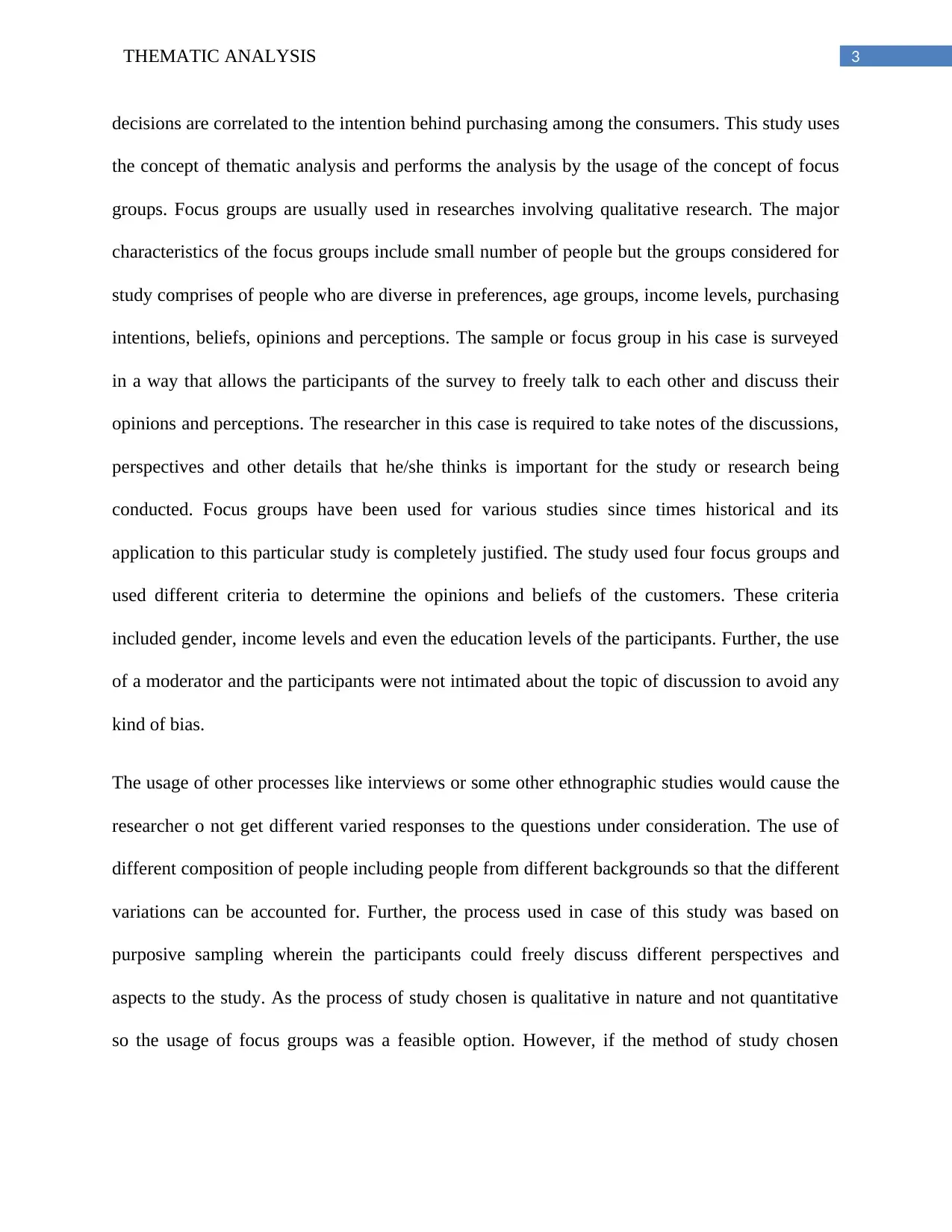
3THEMATIC ANALYSIS
decisions are correlated to the intention behind purchasing among the consumers. This study uses
the concept of thematic analysis and performs the analysis by the usage of the concept of focus
groups. Focus groups are usually used in researches involving qualitative research. The major
characteristics of the focus groups include small number of people but the groups considered for
study comprises of people who are diverse in preferences, age groups, income levels, purchasing
intentions, beliefs, opinions and perceptions. The sample or focus group in his case is surveyed
in a way that allows the participants of the survey to freely talk to each other and discuss their
opinions and perceptions. The researcher in this case is required to take notes of the discussions,
perspectives and other details that he/she thinks is important for the study or research being
conducted. Focus groups have been used for various studies since times historical and its
application to this particular study is completely justified. The study used four focus groups and
used different criteria to determine the opinions and beliefs of the customers. These criteria
included gender, income levels and even the education levels of the participants. Further, the use
of a moderator and the participants were not intimated about the topic of discussion to avoid any
kind of bias.
The usage of other processes like interviews or some other ethnographic studies would cause the
researcher o not get different varied responses to the questions under consideration. The use of
different composition of people including people from different backgrounds so that the different
variations can be accounted for. Further, the process used in case of this study was based on
purposive sampling wherein the participants could freely discuss different perspectives and
aspects to the study. As the process of study chosen is qualitative in nature and not quantitative
so the usage of focus groups was a feasible option. However, if the method of study chosen
decisions are correlated to the intention behind purchasing among the consumers. This study uses
the concept of thematic analysis and performs the analysis by the usage of the concept of focus
groups. Focus groups are usually used in researches involving qualitative research. The major
characteristics of the focus groups include small number of people but the groups considered for
study comprises of people who are diverse in preferences, age groups, income levels, purchasing
intentions, beliefs, opinions and perceptions. The sample or focus group in his case is surveyed
in a way that allows the participants of the survey to freely talk to each other and discuss their
opinions and perceptions. The researcher in this case is required to take notes of the discussions,
perspectives and other details that he/she thinks is important for the study or research being
conducted. Focus groups have been used for various studies since times historical and its
application to this particular study is completely justified. The study used four focus groups and
used different criteria to determine the opinions and beliefs of the customers. These criteria
included gender, income levels and even the education levels of the participants. Further, the use
of a moderator and the participants were not intimated about the topic of discussion to avoid any
kind of bias.
The usage of other processes like interviews or some other ethnographic studies would cause the
researcher o not get different varied responses to the questions under consideration. The use of
different composition of people including people from different backgrounds so that the different
variations can be accounted for. Further, the process used in case of this study was based on
purposive sampling wherein the participants could freely discuss different perspectives and
aspects to the study. As the process of study chosen is qualitative in nature and not quantitative
so the usage of focus groups was a feasible option. However, if the method of study chosen
Paraphrase This Document
Need a fresh take? Get an instant paraphrase of this document with our AI Paraphraser
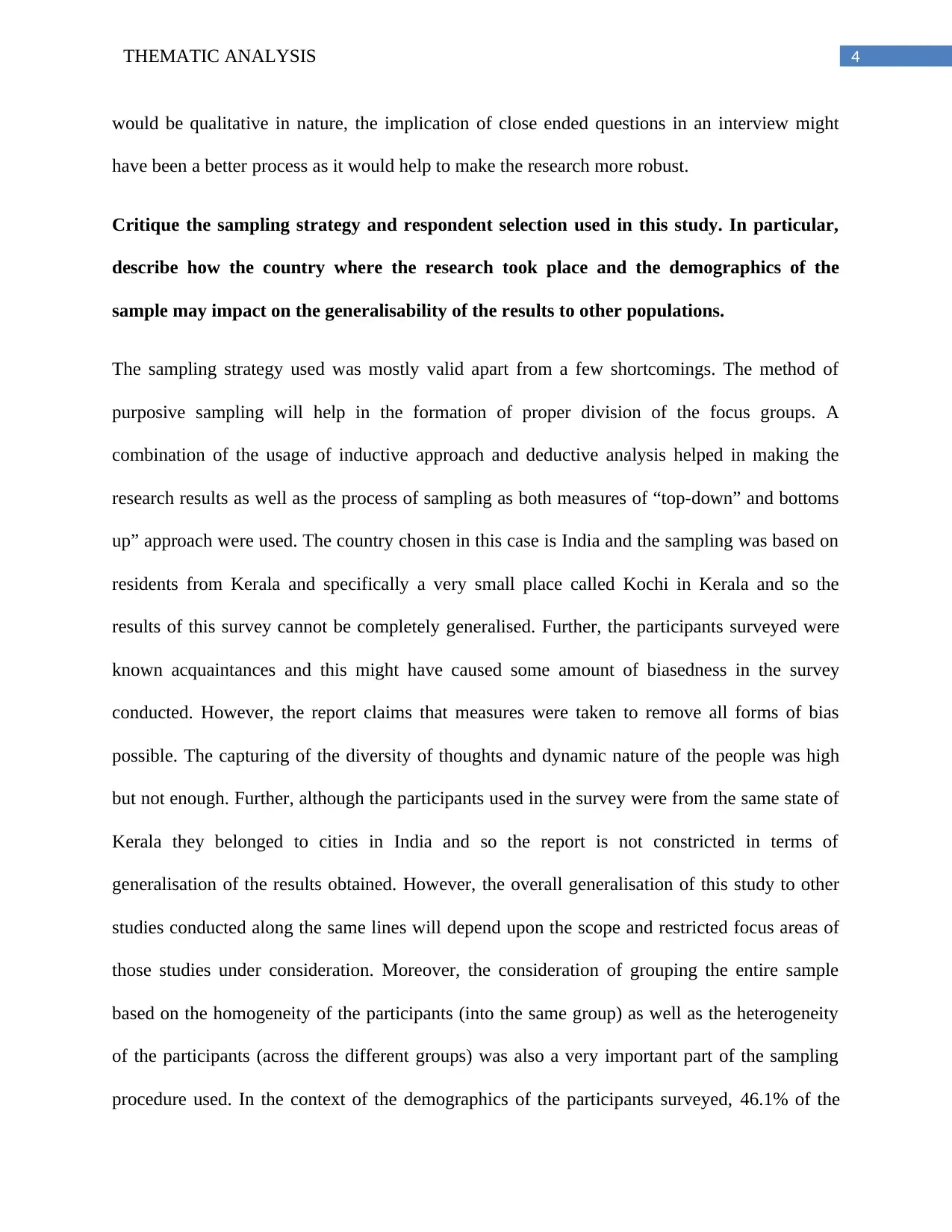
4THEMATIC ANALYSIS
would be qualitative in nature, the implication of close ended questions in an interview might
have been a better process as it would help to make the research more robust.
Critique the sampling strategy and respondent selection used in this study. In particular,
describe how the country where the research took place and the demographics of the
sample may impact on the generalisability of the results to other populations.
The sampling strategy used was mostly valid apart from a few shortcomings. The method of
purposive sampling will help in the formation of proper division of the focus groups. A
combination of the usage of inductive approach and deductive analysis helped in making the
research results as well as the process of sampling as both measures of “top-down” and bottoms
up” approach were used. The country chosen in this case is India and the sampling was based on
residents from Kerala and specifically a very small place called Kochi in Kerala and so the
results of this survey cannot be completely generalised. Further, the participants surveyed were
known acquaintances and this might have caused some amount of biasedness in the survey
conducted. However, the report claims that measures were taken to remove all forms of bias
possible. The capturing of the diversity of thoughts and dynamic nature of the people was high
but not enough. Further, although the participants used in the survey were from the same state of
Kerala they belonged to cities in India and so the report is not constricted in terms of
generalisation of the results obtained. However, the overall generalisation of this study to other
studies conducted along the same lines will depend upon the scope and restricted focus areas of
those studies under consideration. Moreover, the consideration of grouping the entire sample
based on the homogeneity of the participants (into the same group) as well as the heterogeneity
of the participants (across the different groups) was also a very important part of the sampling
procedure used. In the context of the demographics of the participants surveyed, 46.1% of the
would be qualitative in nature, the implication of close ended questions in an interview might
have been a better process as it would help to make the research more robust.
Critique the sampling strategy and respondent selection used in this study. In particular,
describe how the country where the research took place and the demographics of the
sample may impact on the generalisability of the results to other populations.
The sampling strategy used was mostly valid apart from a few shortcomings. The method of
purposive sampling will help in the formation of proper division of the focus groups. A
combination of the usage of inductive approach and deductive analysis helped in making the
research results as well as the process of sampling as both measures of “top-down” and bottoms
up” approach were used. The country chosen in this case is India and the sampling was based on
residents from Kerala and specifically a very small place called Kochi in Kerala and so the
results of this survey cannot be completely generalised. Further, the participants surveyed were
known acquaintances and this might have caused some amount of biasedness in the survey
conducted. However, the report claims that measures were taken to remove all forms of bias
possible. The capturing of the diversity of thoughts and dynamic nature of the people was high
but not enough. Further, although the participants used in the survey were from the same state of
Kerala they belonged to cities in India and so the report is not constricted in terms of
generalisation of the results obtained. However, the overall generalisation of this study to other
studies conducted along the same lines will depend upon the scope and restricted focus areas of
those studies under consideration. Moreover, the consideration of grouping the entire sample
based on the homogeneity of the participants (into the same group) as well as the heterogeneity
of the participants (across the different groups) was also a very important part of the sampling
procedure used. In the context of the demographics of the participants surveyed, 46.1% of the
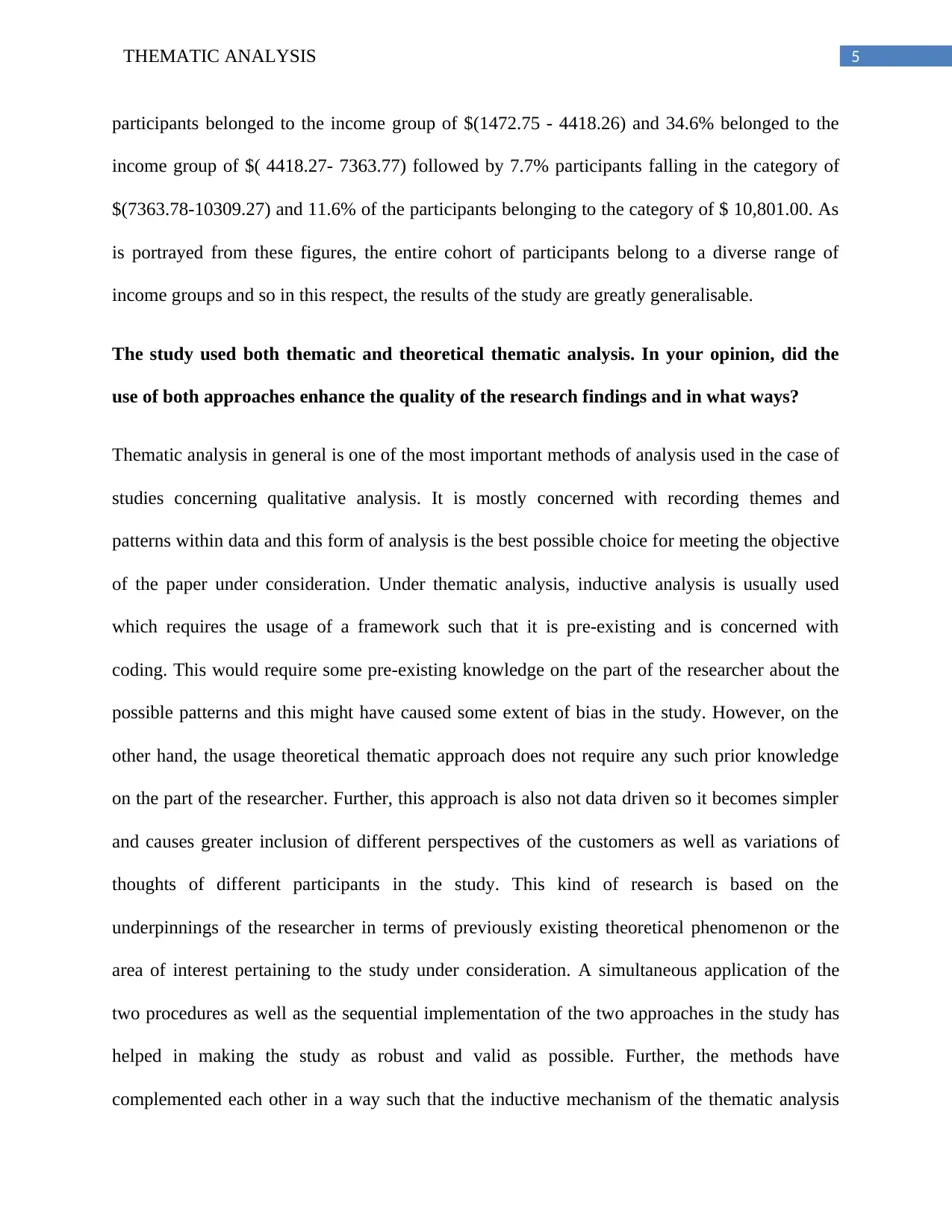
5THEMATIC ANALYSIS
participants belonged to the income group of $(1472.75 - 4418.26) and 34.6% belonged to the
income group of $( 4418.27- 7363.77) followed by 7.7% participants falling in the category of
$(7363.78-10309.27) and 11.6% of the participants belonging to the category of $ 10,801.00. As
is portrayed from these figures, the entire cohort of participants belong to a diverse range of
income groups and so in this respect, the results of the study are greatly generalisable.
The study used both thematic and theoretical thematic analysis. In your opinion, did the
use of both approaches enhance the quality of the research findings and in what ways?
Thematic analysis in general is one of the most important methods of analysis used in the case of
studies concerning qualitative analysis. It is mostly concerned with recording themes and
patterns within data and this form of analysis is the best possible choice for meeting the objective
of the paper under consideration. Under thematic analysis, inductive analysis is usually used
which requires the usage of a framework such that it is pre-existing and is concerned with
coding. This would require some pre-existing knowledge on the part of the researcher about the
possible patterns and this might have caused some extent of bias in the study. However, on the
other hand, the usage theoretical thematic approach does not require any such prior knowledge
on the part of the researcher. Further, this approach is also not data driven so it becomes simpler
and causes greater inclusion of different perspectives of the customers as well as variations of
thoughts of different participants in the study. This kind of research is based on the
underpinnings of the researcher in terms of previously existing theoretical phenomenon or the
area of interest pertaining to the study under consideration. A simultaneous application of the
two procedures as well as the sequential implementation of the two approaches in the study has
helped in making the study as robust and valid as possible. Further, the methods have
complemented each other in a way such that the inductive mechanism of the thematic analysis
participants belonged to the income group of $(1472.75 - 4418.26) and 34.6% belonged to the
income group of $( 4418.27- 7363.77) followed by 7.7% participants falling in the category of
$(7363.78-10309.27) and 11.6% of the participants belonging to the category of $ 10,801.00. As
is portrayed from these figures, the entire cohort of participants belong to a diverse range of
income groups and so in this respect, the results of the study are greatly generalisable.
The study used both thematic and theoretical thematic analysis. In your opinion, did the
use of both approaches enhance the quality of the research findings and in what ways?
Thematic analysis in general is one of the most important methods of analysis used in the case of
studies concerning qualitative analysis. It is mostly concerned with recording themes and
patterns within data and this form of analysis is the best possible choice for meeting the objective
of the paper under consideration. Under thematic analysis, inductive analysis is usually used
which requires the usage of a framework such that it is pre-existing and is concerned with
coding. This would require some pre-existing knowledge on the part of the researcher about the
possible patterns and this might have caused some extent of bias in the study. However, on the
other hand, the usage theoretical thematic approach does not require any such prior knowledge
on the part of the researcher. Further, this approach is also not data driven so it becomes simpler
and causes greater inclusion of different perspectives of the customers as well as variations of
thoughts of different participants in the study. This kind of research is based on the
underpinnings of the researcher in terms of previously existing theoretical phenomenon or the
area of interest pertaining to the study under consideration. A simultaneous application of the
two procedures as well as the sequential implementation of the two approaches in the study has
helped in making the study as robust and valid as possible. Further, the methods have
complemented each other in a way such that the inductive mechanism of the thematic analysis
⊘ This is a preview!⊘
Do you want full access?
Subscribe today to unlock all pages.

Trusted by 1+ million students worldwide
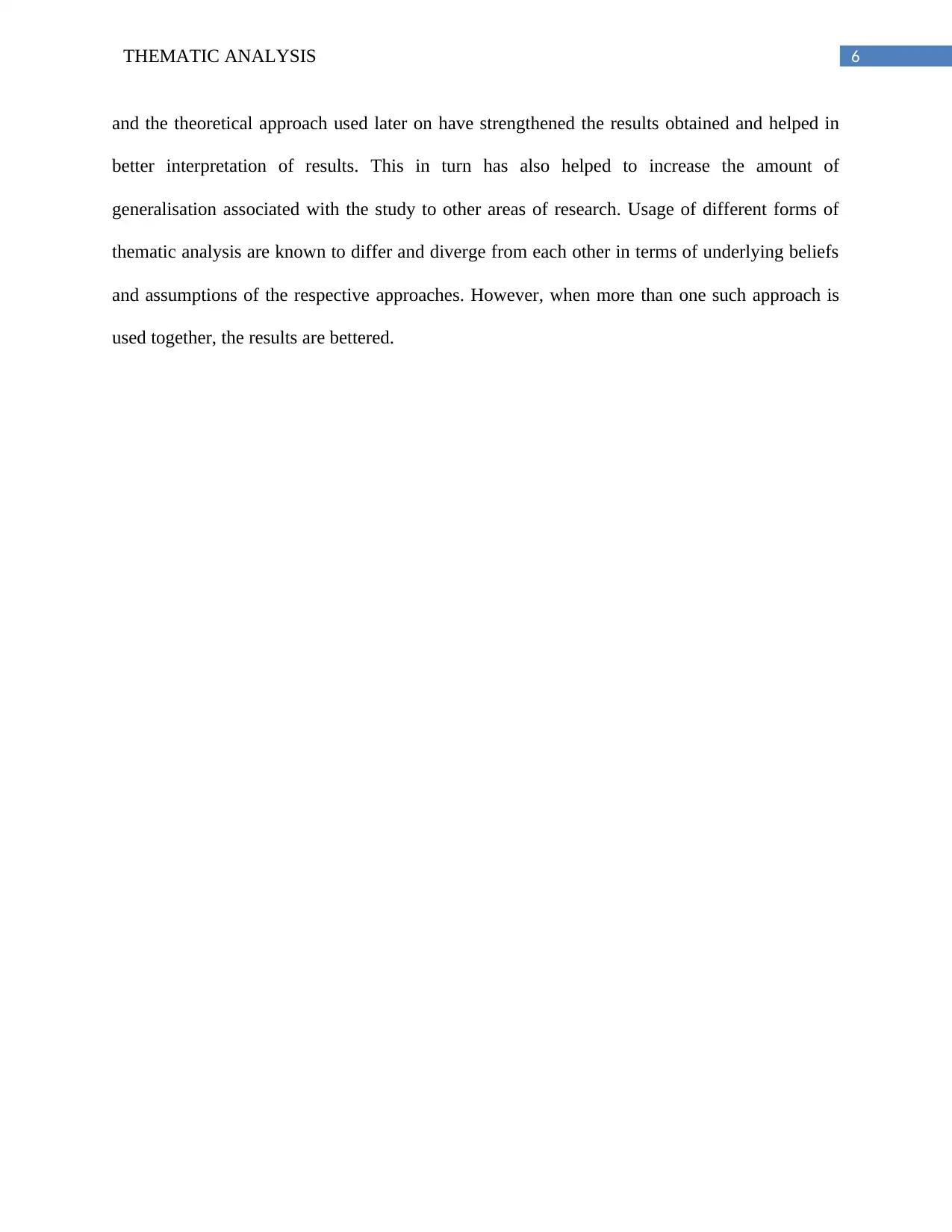
6THEMATIC ANALYSIS
and the theoretical approach used later on have strengthened the results obtained and helped in
better interpretation of results. This in turn has also helped to increase the amount of
generalisation associated with the study to other areas of research. Usage of different forms of
thematic analysis are known to differ and diverge from each other in terms of underlying beliefs
and assumptions of the respective approaches. However, when more than one such approach is
used together, the results are bettered.
and the theoretical approach used later on have strengthened the results obtained and helped in
better interpretation of results. This in turn has also helped to increase the amount of
generalisation associated with the study to other areas of research. Usage of different forms of
thematic analysis are known to differ and diverge from each other in terms of underlying beliefs
and assumptions of the respective approaches. However, when more than one such approach is
used together, the results are bettered.
1 out of 7